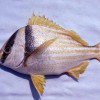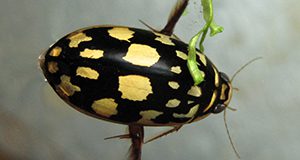Meet a new, attractive, easy-to-keep, local, non-endangered, aquatic pet: the diving beetle! Predaceous diving beetles are aesthetically pleasing yet still rare in US aquariums (though common in countries like Japan), which makes them a fun, new, unusual pet. This 5-page fact sheet written by Craig Bateman and Jiri Hulcr and published by the School of Forest Resources and Conservation provides information about the aquatic beetles, including how to catch and maintain them. Learn how you can befriend these sprightly little insect pals and allow them to bring to your home a mysterious green and quiet world, beautiful silver air bubbles and bronze iridescence, and exciting shows of feeding frenzy. And if you have to part with them, you can safely release the native species into the wild, because they are a part of our Florida natural landscape.
edis.ifas.ufl.edu/fr398
Tag: Aquaria
Candidate Species for Marine Ornamental Aquaculture: Porkfish, Anisotremis virginicus
 The porkfish is a member of the grunt family, which create a characteristic “grunting” sound by rubbing their pharyngeal teeth together during periods of agitation or courtship. Many species of grunts are popular in public aquariums because they’re abundantly available, and their schooling behavior and bright colors create interest in aquarium exhibits. Porkfish also have additional appeal to aquarists because they are “cleaner” fish during their juvenile phase, picking parasites from larger fish and other vertebrates. Scientists and aquarists have recently achieved a greater understanding of appropriate aquaculture protocols for grunts in general and porkfish in particular. These characteristics and advancements have led to porkfish being identified as a candidate species for commercial aquaculture. This 5-page fact sheet was written by Eric Cassiano and Kevin Barden, and published by the UF Department of Fisheries and Aquatic Sciences, October 2014. (Photo by George H. Burgess, Florida Museum of Natural History)
The porkfish is a member of the grunt family, which create a characteristic “grunting” sound by rubbing their pharyngeal teeth together during periods of agitation or courtship. Many species of grunts are popular in public aquariums because they’re abundantly available, and their schooling behavior and bright colors create interest in aquarium exhibits. Porkfish also have additional appeal to aquarists because they are “cleaner” fish during their juvenile phase, picking parasites from larger fish and other vertebrates. Scientists and aquarists have recently achieved a greater understanding of appropriate aquaculture protocols for grunts in general and porkfish in particular. These characteristics and advancements have led to porkfish being identified as a candidate species for commercial aquaculture. This 5-page fact sheet was written by Eric Cassiano and Kevin Barden, and published by the UF Department of Fisheries and Aquatic Sciences, October 2014. (Photo by George H. Burgess, Florida Museum of Natural History)
http://edis.ifas.ufl.edu/fa187
Sharks for the Aquarium and Considerations for Their Selection (FA179)
Sharks are magnificent animals and an exciting group of fishes. And they are becoming increasingly popular as pet animals. The proper care and display of sharks requires great attention to details. This 8-page fact sheet provides critical points aquarists must consider in deciding whether or not to include sharks in their aquaria. A table of the most popular sharks kept in public and home aquariums is provided to facilitate species selection. Written by Alexis L. Morris, Elisa J. Livengood, and Frank A. Chapman, and published by the UF Department of School of Forest Resources and Conservation Program in Fisheries and Aquatic Sciences, December 2010.
http://edis.ifas.ufl.edu/fa179
FA165 Use of Copper in Marine Aquaculture and Aquarium Systems
FA165, a 6-page fact sheet by Roy P. E. Yanong, discusses the use of “bluestone” or “blue copperas” copper sulfate — basic copper chemistry, chelated copper, toxicity to target and non-target organisms, determining dose, reaching and maintaining desired concentrations, and removing copper from the system. Includes references. Published by the UF Program in Fisheries and Aquatic Sciences, School of Forest Resources and Conservation, December 2009.
http://edis.ifas.ufl.edu/fa165
